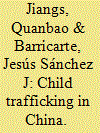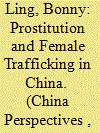| Srl | Item |
| 1 |
ID:
124990


|
|
|
|
|
| Publication |
2013.
|
| Summary/Abstract |
Child trafficking is a serious problem in China. However, there has not been much research in this area. This article introduces the problem of child trafficking in China based on available data. First, the article examines the reasons for child trafficking followed by a summary description of the characteristics of the children who have been victims of trafficking. Next, the article analyzes the process of child trafficking and discusses the fate of the children involved. The article additionally provides a description of the various measures adopted by the Chinese government and NGOs (non-governmental organizations) to combat child trafficking and mentions the resistance to these measures. This article will hopefully draw the attention of the government, academia and the public to this issue.
|
|
|
|
|
|
|
|
|
|
|
|
|
|
|
|
| 2 |
ID:
162089


|
|
|
|
|
| Summary/Abstract |
Prostitution is illegal in China and is frequently the target of law enforcement crackdowns. In recent years, the country’s growing emphasis on combating human trafficking has also increased the profile of these anti-prostitution campaigns. This is seen in China’s current anti-trafficking roadmap, which identifies the nationwide eradication of prostitution as an important prong of the country’s anti-trafficking campaign. The two phenomena of prostitution and trafficking in women, or female trafficking, are nevertheless not equivalent. This article argues that, in the contemporary discourse on prostitution and female trafficking in China, the two issues are often conflated. The two terms are used interchangeably in a way that has affected the conceptualisation of female trafficking as a phenomenon that is largely synonymous with prostitution. This problem is exacerbated by the social stigma attached to women who are engaged in prostitution, regardless of the circumstances of their entry. Another aspect of this discourse is its dissociation from historical context, despite the fact that neither prostitution nor the trafficking in Chinese women for the exploitation of prostitution are newly arrived challenges for the present generation. The article therefore argues that discussions on prostitution and female trafficking in China would benefit from a conceptually clear framework that examines these challenges as more than a singular purpose of exploitation or a challenge of modernity.
|
|
|
|
|
|
|
|
|
|
|
|
|
|
|
|